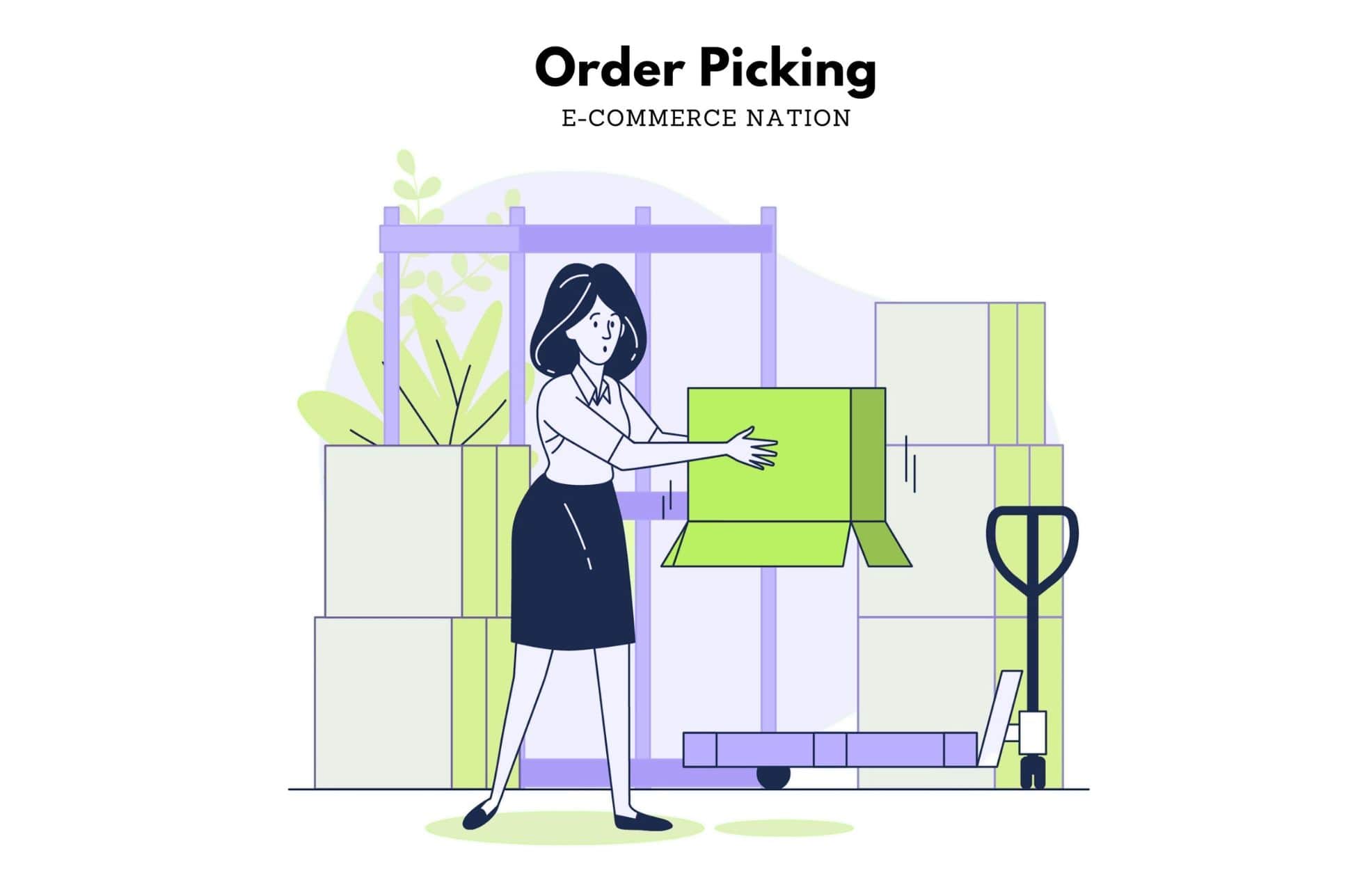The core of any online business is order fulfillment. It starts when your customer places an order and ends when the order arrives on their doorstep. In the space between, a number of steps have to occur including picking and packing. Picking and packing is simply the process through which items in an order are taken from inventory, grouped together, and shipped to the customer.
When it comes to picking and packing, there are many different methods to choose from, and the one that works best for one company might not be the best choice for yours. Keep reading to learn more about the different picking and packing methods and to receive some simple tips for improving your company’s processes.
Understanding the Basics About Picking and Packing
Picking and packing is an essential part of your order fulfillment process. The speed and accuracy with which this stage in the process is completed plays a key role when it comes to reducing costs, improving efficiency, and ensuring customer satisfaction. But what is picking and packing, anyway?
Picking is the process of selecting inventory from storage to be included in a customer’s order. It is the first thing that happens after the order is placed by the customer and received by the warehouse. After picking, the order is packed – this involves gathering all items from an order and preparing them for shipment to the customer.
There are several distinct picking and packing processes that a company or 3PL provider might use. Here are the top 8 picking and packing processes:
- Discrete order picking
- Batch picking
- Wave picking
- Zone picking
- Cluster picking
- Zone-batch picking
- Zone-wave picking
- Zone-batch-wave picking
Different order picking methods are defined by the following: pickers per order, lines per pick, and periods per shift. Pickers per order refers to the number of pickers who work on a single order at the same time. Lines per pick refers to the number of orders that a specific item is picked for at one time. Periods per shift is the frequency of order scheduling during a single shift.
Now, let’s take a closer look at each of these picking methods in greater detail.
-
Discrete Order Picking
This is the simplest method of picking to understand which is what makes it the most common. Simply put, this method involves a single order-picker who picks one order, one line at a time. In most cases there is only one order scheduling window per shift, so orders can be picked at any time during that day. Though this method is simple to employ and ideal for paper-based picking, it is not very efficient because it requires a great deal of travel time compared to other models.
-
Batch Picking
In this picking method, an order-picker picks a group (or batch) of orders all at the same time, one SKU at a time. This method works well when there are multiple orders having the same SKU because the order-picker need only travel to the pick location for that particular SKU one time. By reducing travel time, batch picking increases productivity and it only requires one order scheduling window per shift. It works best with small orders (under four SKUs) and when the physical dimensions of each SKU are small.
-
Wave Picking
Similar to discrete picking, wave picking involves an order-picker picking one order, one SKU at a time. The main difference that that there is a scheduling window for wave picking while for discrete picking there is not. Orders can be scheduled for picking at certain times of day with this method to help coordinate and maximize picking, packing, and shipping operations.
-
Zone Picking
In this picking method, order-pickers are assigned to a specific, physically defined zone within the pick area. Each order-picker is responsible for picking all of the SKUs located within their zone for each order. For orders that require multiple SKUs, the order is filled after passing through each zone. Also known as the “pick and pass” process, zone picking has only one scheduling period per shift which means that there is a cutoff point for orders – any order received after the cutoff point will be scheduled for picking during the next shift.
-
Cluster Picking
This method of picking involves picking into multiple order containers all at the same time. These containers may be ones that contain order batches, discrete order shippers, or discrete order totes. This method of picking is best for pick to cart operations and vertical lift modules. Pick to cart operations involve a cart being loaded with multiple totes or shippers so the order-picker can make a single pass through the pick zone, sorting the SKUs into the relevant pick containers. For vertical lift modules or carousel operations, the independent zone picking technique involves a picker setting up the pick container batch to initiate the mechanized pick module. From there, the items are sorted into the proper pick container.
-
Zone-Batch Picking
A combination of zone picking and batch picking, this method involves order-pickers assigned to a particular zone but they batch-pick within that zone. Because both zone picking and batch picking utilize a scheduling window, zone-batch picking does as well.
-
Zone-Wave Picking
This is a combination of zone picking and wave picking in which the order-picker is assigned to a zone and each picker within that zone picks all of the SKUs for orders stocked within that zone. Orders are picked one at a time with one scheduling window per shift.
-
Zone-Batch-Wave Picking
The most complex of all 8 picking methods, zone-batch-wave picking involves an order-picker assigned to a specific zone in which they pick all SKUs for orders stocked in that zone. Each order-picker picks more than one SKU at a time and there are multiple scheduling windows during each shift.
8 Simple Methods for Improving Picking and Packing Processes
Now that you have a greater understanding of the picking and packing process, you may be wondering how best to improve your business’s operations. Here are 8 simple methods for improving your company’s picking and packing processes:
- Design your warehouse for optimal efficiency.
- Keep your warehouse clean and organized.
- Optimize your storage strategies.
- Double-check each order before shipping.
- Keep your inventory accurately updated.
- Use a pick-to-light or voice picking system.
- Train and incentivize your picking staff.
- Use more efficient packaging.
Let’s take a more in-depth look at each of these methods.
-
Design your warehouse for optimal efficiency.
Depending how large your warehouse is and how many orders you receive, a significant amount of time could be wasted walking from one storage bin to another just to fill each order. The best way to optimize your picking and packing process is to design your warehouse for maximum efficiency. Here are some simple tips to keep in mind:
- Place your top-selling products closest to your packing stations.
- Store items that are often sold together in neighboring storage zones.
- Arrange your inventory from top-selling to low-selling.
Another storage strategy you might consider is called slotting. This is the process of determining where items should be stored in the picking area based on both their popularity and their proximity to the starting point of picking to reduce travel time. In addition to storing popular items near the picking area, you also want to store items at a height where pickers don’t have to bend down or reach up, and you need to space things out to prevent congestion.
-
Keep your warehouse clean and organized.
In addition to optimizing your inventory storage to reduce travel time, you also want to keep things clean and neatly organized for maximum efficiency. Make sure that the supplies your pickers and packers need are neatly organized and easy to access. The floors should be kept clean, and you should remove trash and clutter frequently to avoid accidents. When you receive new inventory, it should be placed in the same area each time for easy picking and packing.
-
Optimize your storage strategies.
The storage strategy that works well for one company may not be ideal for another, so take the time to consider your company’s needs and how best to meet them. Choosing the right storage strategy can increase efficiency and accuracy while the wrong strategy can slow things down. If you have a lot of inventory, implementing a slotting strategy may be best. Keep in mind that you might need to review your storage strategy from time to time, and you might need to make adjustments seasonally to keep up with changes in demand.
-
Double-check each order before shipping.
Even if you’re using warehouse management software, you still need to double-check each order before it is sent out. It only takes a short time for a human to verify the accuracy of an order and it is well worth it to avoid the cost of return shipping, re-shipping another item, and potentially losing a customer in the process. You can also use technology to verify the details of each order as it is filled. For example, you can use pick verification flags where the picker uses a scanner to verify the LPN, quantity, item, and other metrics.
-
Keep your inventory accurately updated.
Your pickers can’t fill an order if the inventory isn’t available, so it is essential to keep your inventory up-to-date and in-stock. When customers place an order just to find out it isn’t in stock, there is a high risk that they will cancel the order and/or choose not to place orders in the future. Inventory management technology is the best way to keep track of things in real-time. Not only can it help you keep tabs on current inventory, but it can alert you when stock is running low or even automatically place orders for popular items. In addition to keeping your inventory updated, you also need to make sure it is properly identified and stored. Don’t mix multiple SKUs in the same pick bin and make sure each bin is accurately labeled for easy identification.
-
Use a pick-to-light or voice picking system.
If your company is still relying on hard copy pick tickets, you could be wasting a lot of time and money – you’re also increasing the risk of human error. One way to improve efficiency is to use pick-to-light or voice recognition technology. In a pick-to-light system, the picker scans a bar-coded label on the box. The digital display on the picking bin will then show the item and quantity that needs to be picked. With voice picking systems, an operator delivers picking instructions via headset. Both of these systems can be used to streamline the picking process in a warehouse.
-
Train and incentivize your picking staff.
Even if you automate your inventory and warehouse management, you must still rely on human pickers to fulfill orders, and that leaves room for error. When it comes to optimal efficiency, you want to reduce travel time and effort for your pickers, so they can complete their jobs comfortably and accurately. Though the actual picking process is fairly simple, you still need to train your staff to perform their tasks safely, accurately, and efficiently. Items in each order should only be touched once – pick items directly into shipping cartons instead of totes to reduce the risk for error. In addition to training your staff, you should also offer incentives. When employees feel valued and rewarded for their work, they are more likely to perform their jobs well and to stay with the job longer.
-
Use more efficient packaging.
Package optimization is a key element in reducing costs and improving efficiency in order fulfillment. Making smart decisions about your packing material can help you control costs and improve the speed and efficiency of transport and shipping. Find the optimal packaging strategy that minimizes unnecessary material as well as the final dimensions of the project. It can also help you save on costs related to freight, inventory carrying, damage, and labor and equipment.
Other Tips for Improving Your Order Fulfillment Process
Improving your picking and packing processes is the key to streamlining order fulfillment, but it is only one piece of the puzzle. Order fulfillment is a complex machine made up of many parts that all work together to complete a common goal – getting the order from the warehouse to the customer in a quick and efficient manner.
Here are some other tips to help you improve your order fulfillment process:
- Consider investing in a Warehouse Management System (WMS). Warehouse management systems control and administer processes from the time products enter the warehouse to when they are shipped out to the customer. If you have a lot of inventory or a high sales volume, investing in a warehouse management system or hiring a 3PL could help.
- Store your inventory according to popularity. How and where you store your products is a major factor in determining the speed and accuracy of order fulfillment. If you group your inventory from fastest-moving to slowest-moving, you can cut down on travel time for your pickers, and you’ll be able to keep better track of when popular items are running low.
- Automate as many processes as you can. Order fulfillment is a multistage process, and by automating as many processes as you can, you can increase speed as well as accuracy. Using 3PL software to automate processes also gives you important data right at your fingertips that you can use to make adjustments and to track progress for reduced risk of error.
- Reevaluate your picking method from time to time. As your company grows and changes, you may need to reevaluate your picking method from time to time. In the early stages, discrete picking may be adequate if you only have a few products and a low sales volume. As your business grows, however, you may need to increase speed and efficiency to keep up with increased demand from your customers.
- Use technology to integrate with your suppliers. Most online retailers don’t manufacture the products they sell, so you are reliant on your suppliers to be able to fill orders. By using technology to integrate with your suppliers, you can stay up to date on slow-downs and hold-ups as well as back orders and other delays that could affect your customers.
In the end, your primary goal is to fulfill orders to your customers’ satisfaction. Streamlining your picking and packing processes in addition to making improvements to your order fulfillment process as a whole are the best ways to accomplish that goal. Take the time to evaluate your current processes to identify the areas in which there is room for improvement then put some of the tips provided above to work!
You can read more about Order Picking in the “Master the Art of Order Picking in E-commerce” article.





